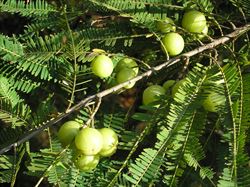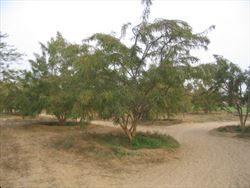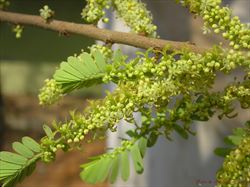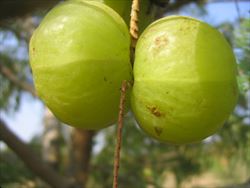Click on images to enlarge

Photo by Lalithamba - Flickr.com (CC BY 2.0)

Photo by Jonathaneo - Wikipedia.org

By L. Shyamal (Own work) [GFDL (http://www.gnu.org/copyleft/fdl.html) or CC-BY-SA-3.0 (http://creativecommons.org/licenses/by-sa/3.0/)], via Wikimedia Commons

Photo by Lalithamba - Flickr.com (CC BY 2.0)

Photo by Jonathaneo - Wikipedia.org
Scientific Name
Phyllanthus emblica L.
Synonyms
Emblica officinalis Gaertn.
Family
Euphorbiaceae (New South Wales, the ACT, Victoria, Tasmania, South Australia, Western Australia and the Northern Territory)Phyllanthaceae (Queensland)
Common Names
amla, emblic, emblic myrobalan, gooseberry, Indian gooseberry, Malacca tree, myrobalan
Origin
Native to China, Taiwan, the Indian Sub-continent (i.e. Bhutan, India, Nepal, Pakistan and Sri Lanka) and south-eastern Asia (i.e. Cambodia, Laos, northern Myanmar, Thailand, Vietnam, Indonesia and Malaysia).
Naturalised Distribution
Locally naturalised in the north-western parts of the Northern Territory.
Also naturalised overseas in Puerto Rico.
Notes
Indian gooseberry (Phyllanthus emblica) is regarded as a minor environmental weed in the Northern Territory and as a "sleeper weed" or potential environmental weed in other parts of northern Australia. This species, which is occasionally cultivated in tropical regions for its edible fruit, has begun to spread from gardens into natural areas.
Indian gooseberry (Phyllanthus emblica) has been recorded in the Moyle River and Finniss River Catchments in the Northern Territory. It is ranked as a medium priority weed species on aboriginal lands in the Northern Land Council area, and is considered to pose a moderate threat to natural areas in this region.
It has also invaded drainage lines in Charles Darwin National Park, in Darwin, where it grows to a considerable size and crowds out native vegetation.

